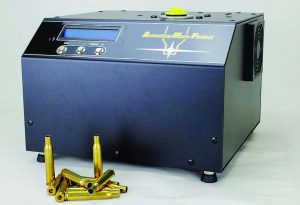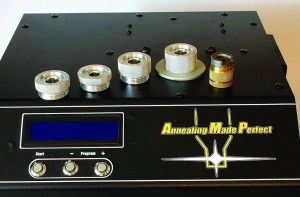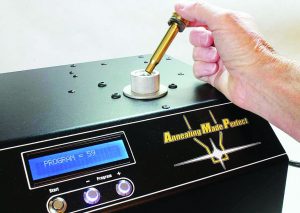By Art Merrill | Contributing Editor
What’s the size of a breadbox and can anneal brass cases safely on your benchtop without heat? The Annealing Made Perfect annealing machine, and no, that isn’t a typo – the AMP annealer uses no high temperature flame or electric element, and annealing a case takes less time than sharpening a pencil. Let’s take a look at the whozits and whatzits of annealing and then try out the AMP annealer.
Why bother?

The AMP is the simplest, easiest and safest method for annealing brass.
In the context of reloading, annealing refers to heating the neck/shoulder area of the brass case to “soften” it. As we fire, resize and reload a case, the brass becomes “work hardened” – that is, more brittle. At some point after repeating these operations over and over again, the neck or shoulder eventually splits, ending the case’s useful life. Annealing returns work-hardened brass back to a malleable state, subsequently increasing the number of times it can be reloaded.
The shade-tree-mechanic method for annealing brass cases is to stand them up in a pan of water and heat the neck/shoulder area with a propane torch. The water prevents heat from softening the case below the shoulder, which would be a bad thing as we want to anneal only the neck and shoulder of the case – softening below that point can cause a case rupture or case head separation. Tipping the case over into the water cools it instantly to permit immediate handling – it does not temper the brass the way submerging heated steel in water or oil tempers that metal.
Yes, with this method annealing is pretty much a waste of time with boringly common cartridges like 9mm Luger and 308 Win; its real suit is in extending the life of hard-to-get obsolete brass cases, or of work-intensive conversions made from other cartridge cases. It can also help to soften necks and shoulders in converting cartridges when necking up or down. But annealing also has an application in reloading precision cartridges.
Improving pie pan precision

Case-specific pilots properly align cases in the magnetic field. A brass grip provides a cool handle for shell holders.
The variables in precision shooting lie with the firearm, the shooter, the ammo and the environment. We cannot control the weather, but we do have control over the other variables. The firearm is the easiest: just throw enough money at it and you’ll eventually get what you want. Developing marksmanship skill is the most difficult because it is utterly dependent upon personal dedication of time and effort – and some immeasurable degree of inherent ability —that no amount of money can buy.
The ammunition can be simplest of all if we buy factory loaded cartridges, or if we roll our own we can choose to make it as complex as a squirrely girlfriend. There’s a lot we can do to a brass case to help turn it into a precision cartridge: weigh and separate, trim, chamfer, ream and turn necks, uniform the primer pocket, bevel the flash hole, even square up the case head. However, in the pursuit of a load that crowds every succeeding shot as close as possible to where the previous shot landed, the key is to make every case and cartridge as identical as we can.
A torch and a pie pan aren’t going to give us cases annealed to exactly the same degree because the method doesn’t permit a precise application of the same amount of heat for exactly the same length of time uniformly at every point around the case neck and shoulder. Annealing for precision shooting requires just that – precision. That’s because annealing affects case neck tension, how willing or reluctant the case neck is to release a bullet upon firing. Necks annealed to different degrees result in bullets released under slightly different amounts of pressure, or said another way, a bullet held with more tension builds up more pressure behind it before it is released to move down the bore, compared to a bullet held with less tension. Case-to-case variations in neck tension can contribute to bullet dispersion at the target.
Does this really make any difference when we’re trying to shoot minute-of-deer at 200 yards? Probably not! But in trying to crowd all bullets into the same hole, or vaporize little rodents at 500 yards, perhaps yes.
Molecules and computers

Select program number, install the pilot and you’re ready to anneal.
The AMP machine works by induction, the same principle that heats pots on a kitchen induction stove. Simplified, the AMP oscillates a magnetic field at high frequency; pushing a piece of brass into this oscillating field excites the brass molecules, causing them to heat, and the brass anneals. Though the AMP does not create heat per se, it does begin to heat noticeably after annealing a few score cases; if it becomes too warm for the electronics, an internal thermostat shuts the unit down until it cools enough to permit safe annealing again.
When we get down to this molecular level, differences in brass thickness and composition will anneal to different degrees, given the same temperature and time of exposure, according to AMP company owner Alex Findlay. For this reason, the AMP machine’s field intensity and duration are computer controlled to anneal cases so precisely that it can be programmed to perfectly anneal a manufacturer’s specific lot of brass. To accomplish this, Alex said AMP has tested a great many different cases to calibrate computer programs for specific brass. If you have brass not on the company’s online list, you can send them a half-dozen ready-to-load, unprimed cases and AMP will test them and add your cases to the ever-expanding list; that is, in fact, how AMP expands its list. The only cost to you is shipping the inert brass to AMP in New Zealand.
Doing it
At the loading bench, programming the AMP machine requires only punching a number into the keypad; for example, my Lake City ‘96 5.56 NATO brass is program #28; my Remington brass for 260 AI is #42.
After programming the AMP, thread the appropriate case pilot (each is specific and sold separately) into the machine. Fix your shell holder – the same one you use in your press – into the AMP’s brass shell holder grip (brass to permit cool handling). Seat the case into the shell holder, insert it into the machine, press the START button, and in about two seconds, it’s done. Next case! The speed with which you can get through a couple of match’s worth of brass is remarkable; quantifying convenience is a bit more subjective, but let’s give it a shot: There is no propane to alarm other house members, nor bottles to store or run out of or throw away; no bulky, irregular contraption cluttering a shelf; no involved setup or takedown – the AMP is “plug & play” and fits neatly just about anywhere.
Honestly, at around $1,000 the AMP’s price point is a bit high to appeal to everyone, but avid precision shooters who roll their own and the reloader with a broad interest in shooting obsolete calibers should take a close look. The commercial reloader, especially those specializing in cartridge conversions, might find it valuable in turning out highest quality ammunition, as well.
For more detailed information on the AMP annealer, visit https://www.ampannealing.com.



